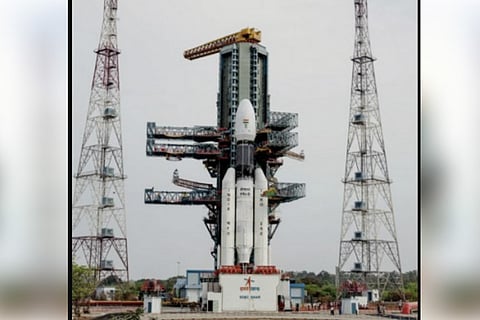

Just weeks after India set a record by launching the highest number of satellites on a single rocket, India’s heaviest rocket to date – the Geosynchronous Satellite Launch Vehicle-Mark III (GSLV-Mk III) – blasted off on Monday evening at 5.28 pm.
Precisely at 5.28 p.m., the GSLV-Mk III rocket, on its maiden flight, began its ascent towards space from the second launch pad at the Satish Dhawan Space Centre (SDSC).
16 minutes later, at 5.44pm, the GSAT-19 Sattelite successfully separated from the launch vehicle.
The success is a major step ahead in making India self-reliant as the space project is an entirely indigenous one. GSLV Mk III's success means India can ferry two to three astronauts into space soon.
The 43.43 metre tall, 640 ton rocket, will, just over 16 minutes into its flight, sling the GSAT-19 at its intended orbit at an altitude of 179 km.

The rocket, weighing 640 tonnes and standing 43.43 metres tall, took off from the second launch pad at India's rocket port at the Satish Dhawan Space Centre in Sriharikota in Andhra Pradesh.
According to reports, the rocket weighs as much as five fully-loaded Boeing jumbo jets or 200 adult elephants.
#WATCH ISRO launches GSLV Mark III carrying GSAT-19 communication satellite from Sriharikota, AP https://t.co/qD3Z2almEr
— ANI (@ANI_news) June 5, 2017
Strapped onto the rocket is the heaviest satellite to be lifted by an Indian rocket – the GSAT-19 communications satellite weighing 3,136kg – which will be carried to an altitude of around 179 km above the Earth.
Monday’s mission is a historic one in terms of both the launch vehicle and the satellite it is carrying.

The three-stage rocket, equipped with an indigenous cryogenic engine that uses liquid oxygen and liquid hydrogen for propulsion, will allow India to launch its own heavy satellites (up to a limit of four tonnes), instead of paying out massive amounts to foreign space agencies.
"The rocket's design carrying capacity is four tonnes. The payload will be gradually increased in future flights of the GSLV Mk-III," K. Sivan, Director, Vikram Sarabhai Space Centre, told IANS earlier.
The Indian space agency had flown a similar rocket in 2014 without the cryogenic engine but with a 3.7-tonne payload mainly to test its structural stability while in flight and the aerodynamics.
S Somanath, Director, Liquid Propulsion Systems Centre, told IANS that the inputs of the 2014 mission enabled the ISRO to reduce the rocket load by around 20 per cent.
Interestingly, GSLV-Mk III at around 43 metres is slightly shorter than Mk-II version that is around 49 metres tall.
"The new rocket may be slightly short but has more punch power," an ISRO official told IANS.
If successful, the GSLV Mk-III is also likely to become India’s launch vehicle of choice for manned missions in the future.
The GSAT-19 communications satellite is also of vital strategic importance. One of the key technologies that the satellite is carrying is a Geostationary Radiation Spectrometer (GRASP), which will study how space radiation affects satellites and their electronic components, in order to build more hardy, radiation-resistant satellites.
More importantly, the GSAT-19 employs a new method of transmitting and receiving data, using multi-frequency beams, which will open up new satellite-based internet capabilities for the country, particularly for parts that are not covered by the optic fibre cable networks.
In this, the GSAT-19 is said to be precursor to the GSAT-11, a 5.8 tonne mega satellite that will push the country’s satellite-based internet capabilities to new levels.
The success is a major step ahead in making India self-reliant as the space project is an entirely indigenous one. GSLV Mk III's success means India can ferry two to three astronauts into space soon.
You can access the ISRO official broadcast here.
(with IANS inputs)